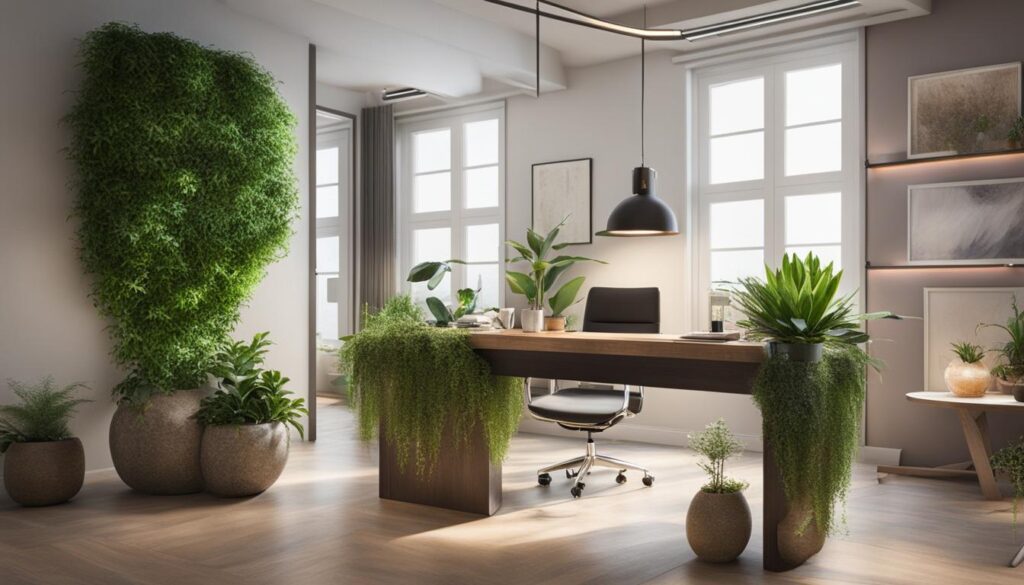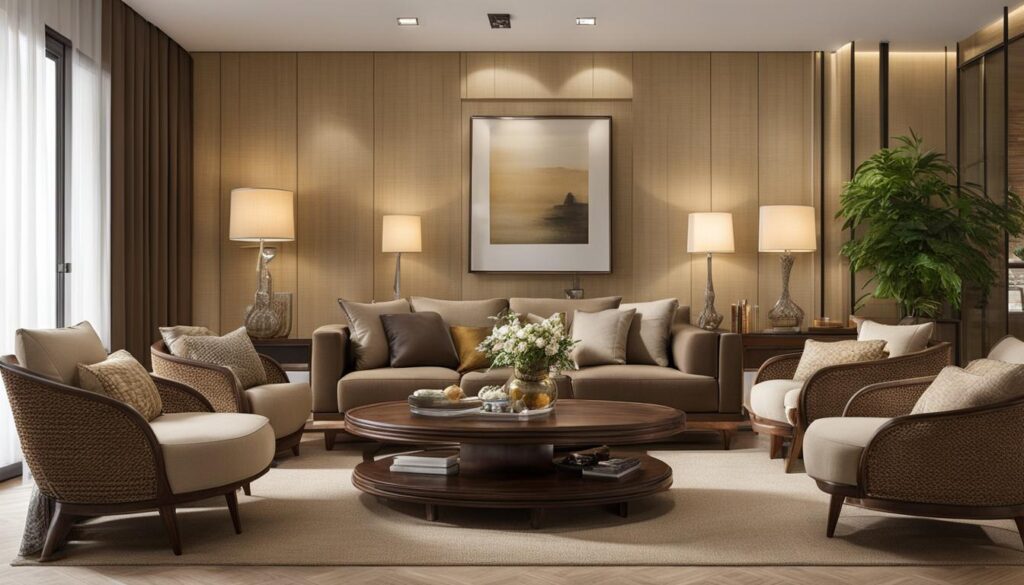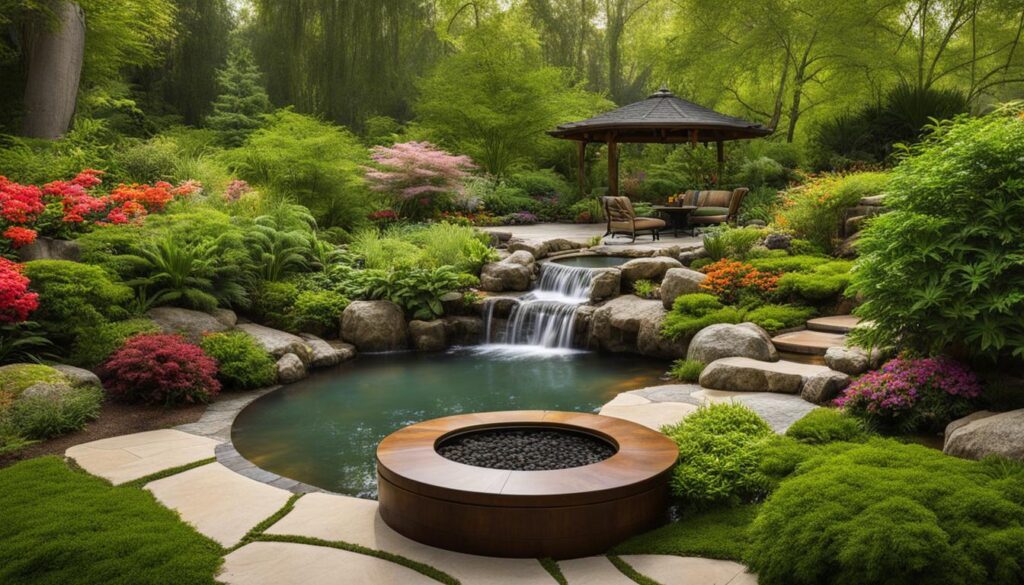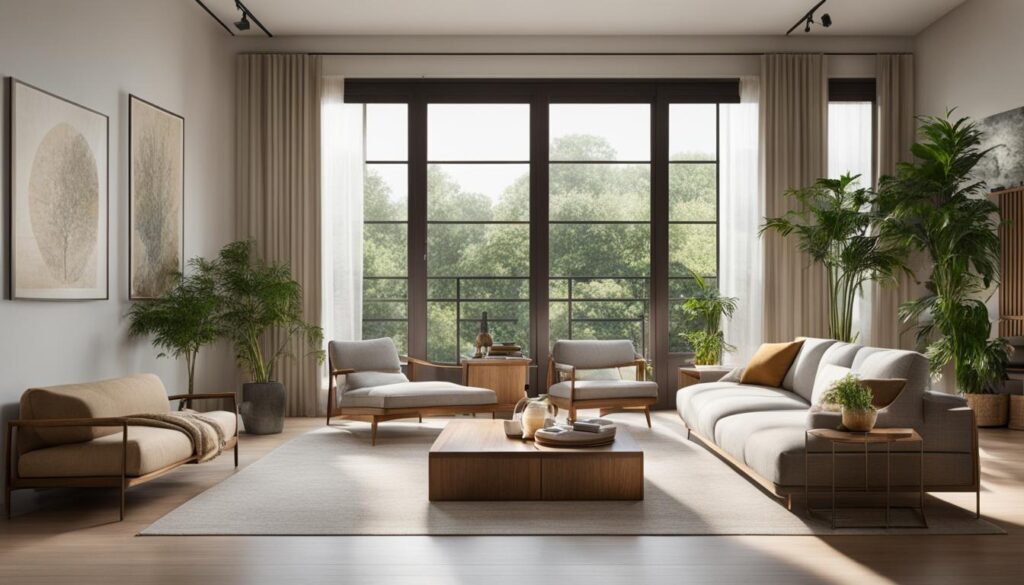As I delve into the artful world of feng shui for home, I’m constantly amazed at how ancient wisdom translates into modern serenity. Embracing feng shui decorating rules is not just about placing objects; it’s a philosophy that intertwines our lives with the spaces we inhabit. The traditional feng shui rules bring forth an approach that seeks to harmonize our environment through meticulous design and thoughtful arrangement.
Feng shui principles are more than mere guidelines—they are the keystones of crafting a living space that breathes positivity and balance. By applying these time-honored feng shui tips, we open our homes to a flow of good energy, or ‘chi’, that empowers and rejuvenates. To share knowledge on these feng shui techniques is to equip you with the tools needed to transform your sanctuary into a source of peace and vitality.
Key Takeaways
- Discover the transformative power of traditional feng shui rules in creating a balanced home environment.
- Understand the importance of decluttering and strategic design in optimizing the flow of chi.
- Learn how soft color palettes can be utilized to invoke tranquility in your living spaces.
- Explore the impact of natural elements and lighting in aligning with feng shui principles for positive energy.
- Gain insight into the significance of furniture placement and room focal points in accordance with feng shui techniques.
Embracing Feng Shui Basics for Positive Energy Flow
When I begin to infuse my living space with the essence of feng shui, I’m embarking on a transformative journey to harmonize my environment and tap into the reservoir of feng shui for positive energy. It’s a delicate dance with feng shui elements—an ancient ritual that enlightens my understanding of how to apply feng shui for good luck and well-being.
For those of us seeking to immerse ourselves in feng shui basics, it’s essential to grasp not merely the aesthetic but, more significantly, the energetic impact it has on our daily existence. The art of feng shui interior design rules starts with something as simple as decluttering, yet its effects can ripple through our lives, ensuring chi, the life force, flows unimpeded.
Understanding Chi and the Importance of Decluttering
Chi is invisible, yet its presence is felt when a room simply ‘feels right.’ A clutter-free room is not just visually appealing—it enhances the flow of this vital energy. Feng shui decorating rules suggest that I need to sift through my possessions, keeping only that which serves a purpose or brings joy. Areas often overlooked—closets, the space beneath the bed—must also be addressed, for they too are havens for stagnant energy that could dampen a home’s vibrancy.
Soft Colors for Serenity: The Feng Shui Palette
In my quest for serenity within my home, the palette plays a pivotal role. The feng shui decorating ideas I embrace should include soft hues that enhance a sense of calm and tranquility. Creams and pale blues conjure a serene backdrop, while accents of green suggest growth, and hints of pink foster love. This alignment with nature’s spectrum is essential in fostering a supportive and nurturing atmosphere.
Strategic Lighting: Setting the Mood with Luminosity
Light is the touchstone of ambiance. As I explore feng shui guidelines, I learn that the positioning of light sources, the warmth of their glow, and their ability to adjust with the crescent and wane of the day, can dramatically shift the energy of a space. Soft ambient lighting invites a flow of positivity, crucial for a home that is a sanctuary from the world’s frenzy.


With every item I select, every shade I paint, and every bulb I illuminate, I am not only decorating—I am setting the stage for vitality, success, and joy. Following feng shui guidelines is not just about aesthetics; it’s about crafting a space where chi moves freely, and where every corner breathes life into my home, fostering an environment ripe for good fortune.
Bringing the Elements Indoors: Feng Shui by Room
When I think about feng shui by room, I visualize a tapestry, finely interwoven with threads of the ancient philosophy’s five elements: fire, earth, metal, wood, and water. Each element brings a unique energy, influencing our emotions and actions. For example, in my office, I follow feng shui guidelines strictly, understanding the importance of a supportive and flourishing environment for productivity and success.
Feng shui techniques aren’t just about placing objects randomly; it’s about intentional placement to nurture and inspire. In the office, a plant symbolizing wood element promotes growth, creativity, and the flowing nature of life’s endeavors. I pair this with metallic items, like a sleek desk lamp or frames, to foster mental clarity and focus.
- Wood – Growth, Flexibility, Creativity
- Fire – Passion, Energy, Expansion
- Earth – Stability, Nourishment, Care
- Metal – Logic, Intelligence, Efficiency
- Water – Wisdom, Serenity, Prosperity
Choosing colors is also strategic in feng shui for office and home spaces. I have opted for a calming blue for tranquility and focus, vibrant reds to inject passion and energy into my work, and earthy tones to keep me grounded and balanced. Each hue sets the stage for the intended mood and activity of the room.


In the living room, I create a space for togetherness and comfort, embracing the earth element with a beautiful terracotta vase that anchors the room and radiates warmth. Metal accents reflect sophistication and earthy tones complement the overall serenity. It’s harmonizing within the philosophy of feng shui, but also aesthetically bringing pleasure and relaxation.
- Select vibrantly lush plants to introduce the wood element and stimulate creativity in the living spaces.
- Add a water feature like a small fountain or fish tank for flow and prosperity in your work or study area.
- Incorporate candles and natural lighting to bring the fire element’s warmth and dynamism into gathering areas.
- Use earthy ceramics and stones to ground the energy in bedrooms and tranquil spaces.
- Place metallic objects strategically in your office for mental sharpness and improved workflow.
From my experience, each home is unique, with each room providing an opportunity to craft an environment that speaks to your personal journey. Utilizing the feng shui guidelines, I’ve seen dramatic improvements in not just the atmosphere of my spaces but in my overall sense of well-being. It’s about creating a cohesive environment that balances all aspects of life.
Feng Shui Guidelines for Furniture and Layout
As I delve into the art of balancing my home with feng shui principles, I’ve come to appreciate the profound effect of strategically arranging furniture for not only aesthetic appeal but also to enhance the feng shui energy flow. Through thoughtful feng shui furniture layout and decoration, every element placed in my living space is aimed at attracting feng shui for good luck and fostering feng shui for positive energy.
Choosing Comfort and Harmony in Furniture Selection
Comfort is pivotal in feng shui house design rules. I ensure that each piece of furniture I select offers comfort and support, key features that turn a house into a home. This principle spans from the living room’s plush sofa to the bedroom’s ergonomically-sound mattress. Each choice is reflective of feng shui rules for rooms, aiming to promote relaxation and a genuine sense of peace for anyone who enters.
Designing with Intention: The Feng Shui Command Position
The feng shui command position isn’t just about placing furniture; it’s about setting the stage for ownership and command over my life. I position my bed and desk so I can see the door without being directly in line with it, symbolically expressing my readiness for opportunities and challenges that may come my way. Such intentional design aligns perfectly with my understanding of rules of feng shui house, reinforcing a sense of security and control.
Water Elements and Natural Textures for a Balanced Abode
Integrating water elements, such as fountains, contributes to the serene ambiance of my space. The tranquility of flowing water not only calms the mind but also stands as a feng shui signifier of abundance and clarity. I further enhance the balance within my home by incorporating natural textures like wood and stone—each element chosen for its inherent grounding properties and alignment with feng shui decorating ideas.


My journey with feng shui has taught me that the spaces we occupy are a reflection of our inner world, and by following these feng shui elements and feng shui house design rules, I consciously create a sanctuary that is not just visually pleasing, but also spiritually fulfilling.
Feng Shui Rules for a Peaceful and Inviting Outdoor Space
As I immerse myself in feng shui for home, it becomes clear that the principles guiding the harmony inside should seamlessly extend to the outdoors. It’s not just about aesthetic pleasure; it’s about creating an environment where energy—or ‘chi’—flows gracefully, enhancing well-being and prosperity. Here are some feng shui tips and feng shui techniques you can employ to nurture a serene and vibrant outdoor living area.
- Unobstructed Paths: The approach to your home sets the stage for the overall energy of your space. Ensure walkways are free of obstructions, inviting positive chi to meander to your doorstep.
- Wind Chimes: Adding wind chimes capitalizes on their sweet melodies to cure negative energy, while their movement stirs the surrounding air, keeping the energy fresh and active.
- Water Features: Incorporating elements of water, such as a small fountain, is a classic feng shui technique to attract wealth and inject a sense of continuous flow and renewal into your space.
Plants also play a pivotal role in outdoor feng shui elements. Beyond their aesthetic appeal, they serve as natural barriers, cocooning you from external noise and unfavorable energies. Hedges or bamboo plantings can form a protective yet inviting boundary.
- Strategic Planting: Position plants around areas where you wish to encourage energy concentration, like seating areas or near the entrance, to welcome guests with lush vitality.
- Mindful Maintenance: Tend to your garden with care. Overgrown or neglected landscapes can become energy blockades rather than conduits.
Following these feng shui guidelines, you can transform your outdoor space into not just an extension of your home, but a foundational pillar in the overall energy alignment of your living environment. Remember, each adjustment you make is a step towards harmonizing with the natural world, fostering an outdoor sanctuary that offers reprieve and rejuvenation.


Conclusion
In my exploration of the artful tradition of Feng Shui, I’ve discovered the profound impact of arranging environments to promote positive energy and balance. What are basic Feng Shui rules for a house? They involve cultivating a space where the vibrant life force known as chi can gracefully flow. This journey is far more than an exercise in exquisite decor—it’s an invitation to fashion a sanctuary that pulsates with vitality and serenity. At the heart of Feng Shui principles lies the concept of harmony; each choice, from decluttering to the artful placement of elements, contributes to a cohesiveness that can elevate the mundane to the extraordinary.
Moreover, my exploration extended beyond the walls of residential domains, journeying into the realms of productivity with Feng Shui for the office. Here I uncovered Feng Shui techniques tailored to empower focus and curate an atmosphere ripe for innovation. By aligning with Feng Shui interior design rules, the environments where we dwell and toil can morph into landscapes that inspire and invigorate. From the subtle influence of color selection to the strategic alignment of our furniture, each aspect resonates with the age-old principles of Feng Shui, crafting spaces that not only inspire visually but resonate with an aura of well-being and comfort.
In essence, the basics of Feng Shui lay the foundation for living spaces that encapsulate a sense of peace and fluid energy. The principles of Feng Shui serve diligently as guides, enabling us to navigate the architectural dance of space and form. These venerable guidelines offer a rich tapestry woven with the threads of tradition and modern sensibility, uniting to create ambiences that foster rejuvenation and joy in every facet of our habitations. Indeed, applying these idioms has revealed to me that a home touched by Feng Shui is not just an abode of beauty but a bastion of balanced energy, harmonizing with the universal rhythms of the cosmos.
FAQ
What are the basic feng shui rules for a harmonious home?
The basic feng shui rules for creating harmony in the home emphasize decluttering to enhance chi flow, using a serene color palette to foster tranquility, arranging furniture according to the Feng Shui principles (like the Command Position), incorporating the five elements (wood, fire, earth, metal, and water) for balance, and ensuring good lighting to set the appropriate mood. Additionally, integrating water elements and natural textures adds to the balance and flow of positive energy.
How does chi and decluttering influence feng shui in a home?
Chi is considered the life force in feng shui, and a clutter-free space allows chi to flow smoothly, influencing the health, happiness, and prosperity of the home. Regular decluttering removes obstacles to chi, creating an environment that’s not only organized but also energetically balanced, promoting a sense of well-being.
What colors are recommended for a Feng Shui home?
Feng shui recommends using soft, neutral colors such as beige, white, pale blue, and other earthy tones to create a calming ambiance. These shades are believed to foster tranquility, joy, clarity, and growth, contributing to the serene and harmonious energy of the home.
How should I position my furniture according to feng shui?
Furniture should be positioned to support comfort and relaxation, with a special focus on the Feng Shui Command Position. This means placing beds and desks so that you have a clear view of the room’s entrance without being directly in line with the door, creating a sense of safety and command over your environment.
Can you give tips on how to apply feng shui for positive energy in the workplace?
To apply feng shui in the workplace, keep your space decluttered, choose ergonomic furniture, and position your desk in the Command Position. Incorporate the five elements for balance, use calming colors, and ensure proper lighting. Add plants to enhance vitality and choose artwork that inspires productivity and success.
What are some feng shui decorating ideas for the bedroom?
For the bedroom, use soothing colors, choose comfortable and supportive bedding, and keep the space free of clutter, especially under the bed. Ensure your bed is in the Command Position, and introduce elements that promote a relaxing atmosphere, such as soft lighting, calming artwork, and simple decorations that evoke peace and relaxation.
How can I integrate feng shui elements into my living space?
You can integrate feng shui elements by including objects and decorations associated with each of the five elements. For example, wood can be introduced through furniture or green plants, fire with candles or red accents, earth through ceramics or earthy colors, metal with metallic frames or sculptures, and water with mirrors, aquariums, or fountains. Balance these elements according to the bagua area and your personal goals.
What are some feng shui principles I should follow when arranging my living room?
In the living room, focus on creating a social and welcoming space. Position furniture to promote conversation but also maintain a clear path for chi to flow. Incorporate a balanced mix of the five elements, use a harmonious color scheme, avoid sharp corners pointing towards seating areas, and include natural light and fresh air when possible.
How does lighting affect feng shui in a home?
Lighting plays a critical role in feng shui as it can influence the energy and mood of a space. Soft, warm lighting is preferred to create a cozy and welcoming atmosphere. Natural lighting should be maximized during the day, while in the evening, adjustable lighting options can help maintain a harmonious balance in the room’s energy.
Why are water elements and natural textures important in feng shui?
Water elements, like fountains and aquariums, bring the calming energy of water into the home, which is associated with wealth and wisdom. Natural textures, such as wood, stone, and natural fibers, help connect us to the natural world, promoting a grounding and comfortable atmosphere that supports a balanced flow of chi.
What feng shui guidelines should I consider for my outdoor space?
For your outdoor space, feng shui suggests keeping pathways clear and well-maintained, using plants and wind chimes to enhance positive energy, and considering the use of water features to attract wealth and prosperity. Natural barriers can serve as protection against negativity, and outdoor lighting can ensure the area is inviting and safe.

